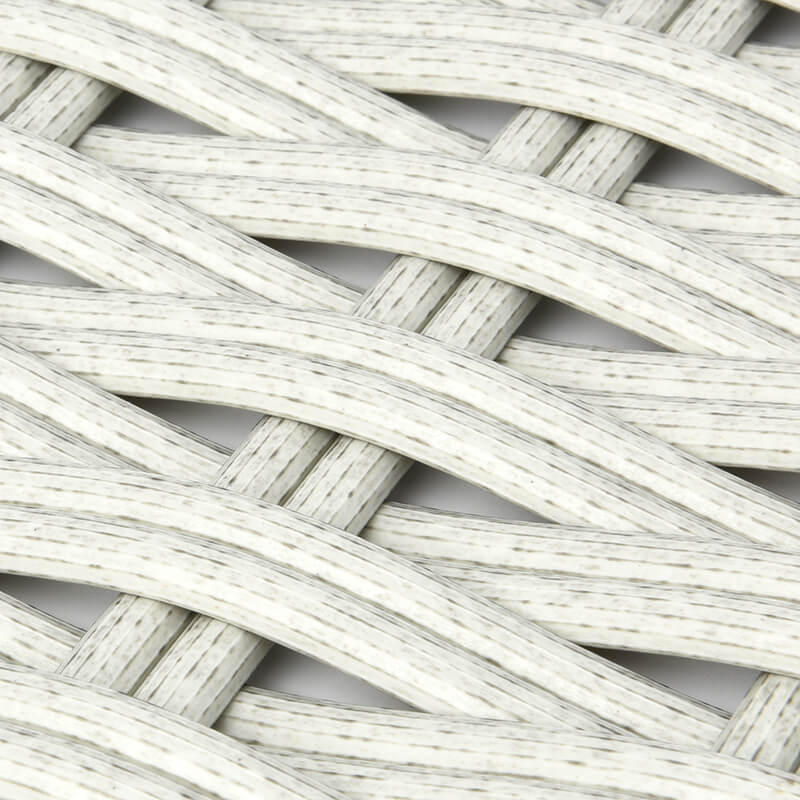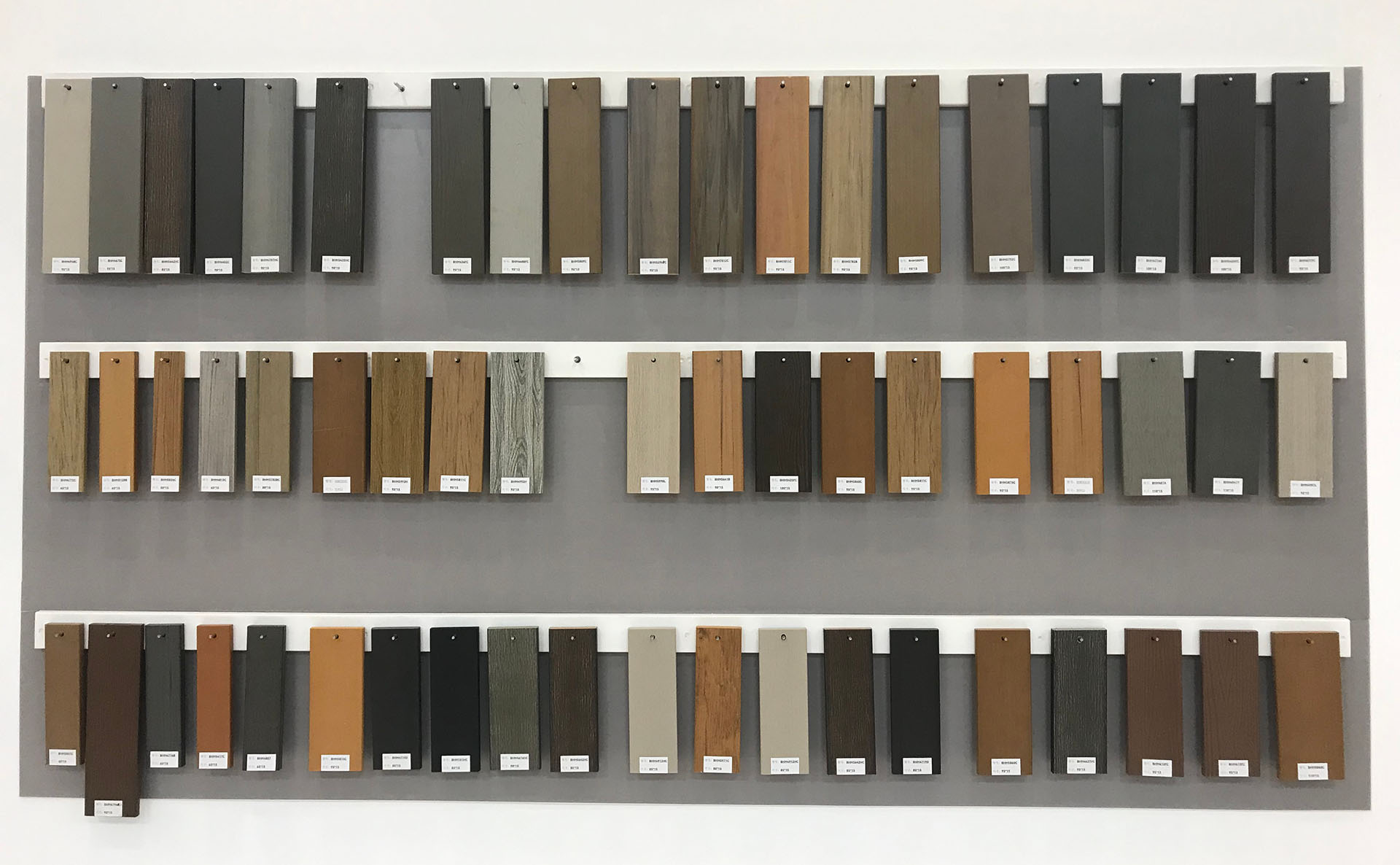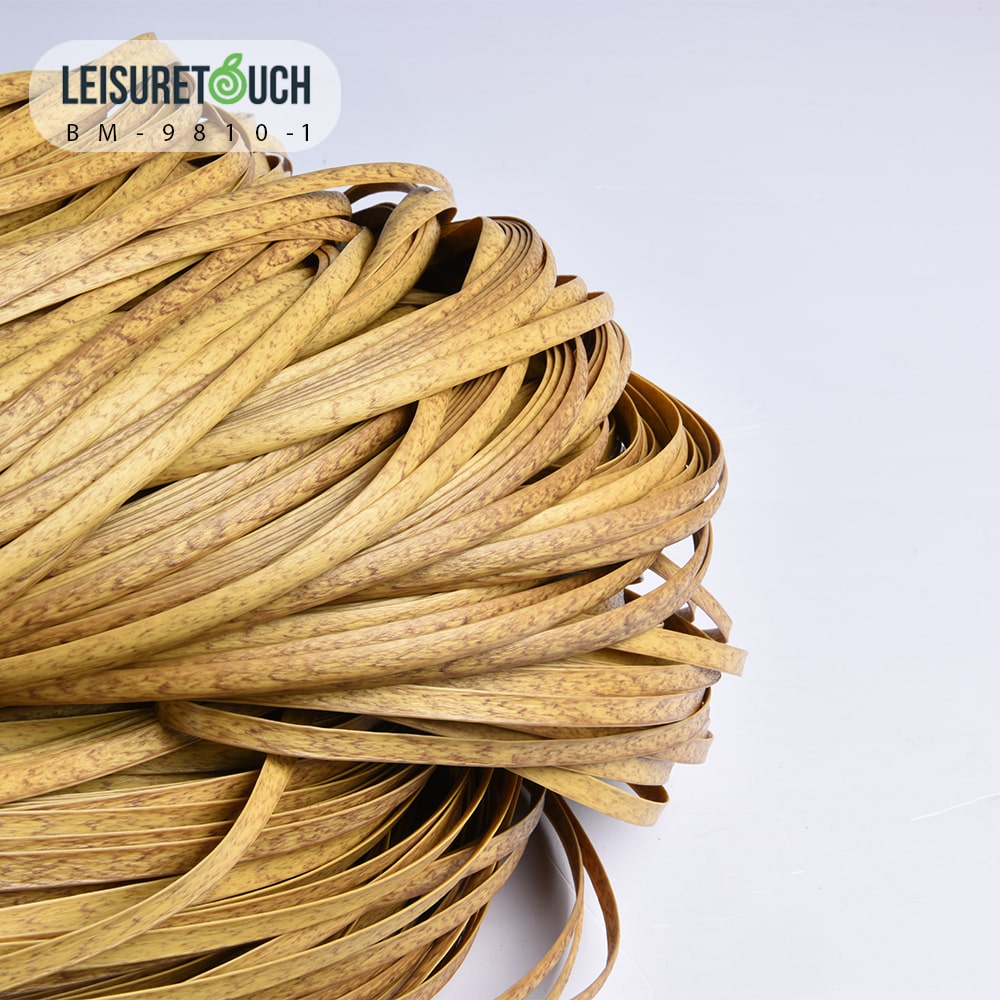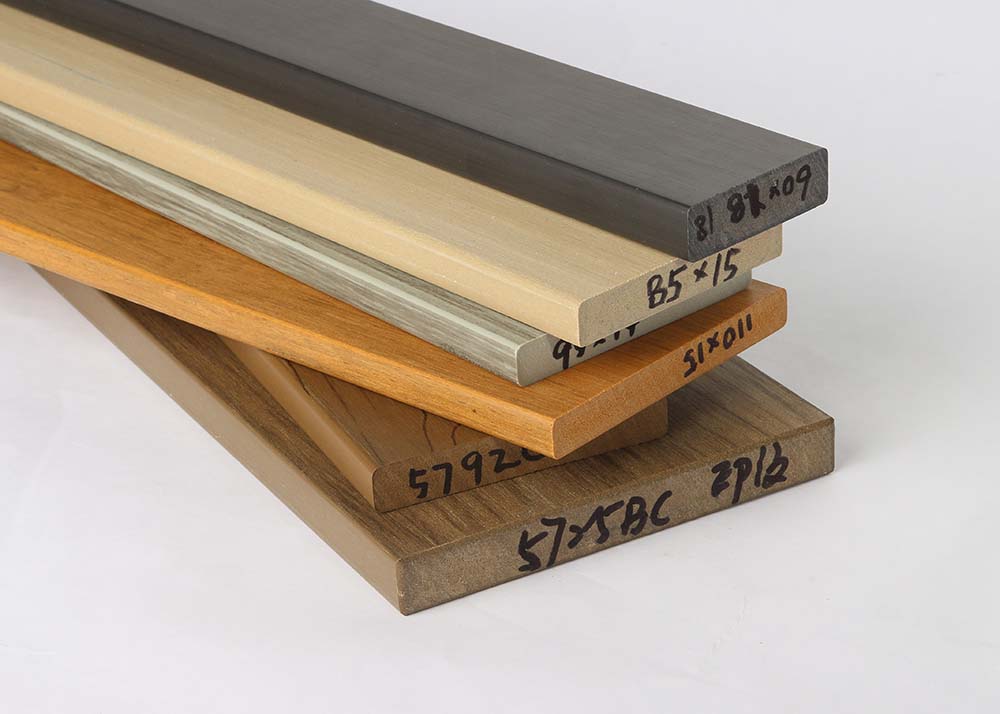Introduction
As a versatile and stylish material for interior design and craftsmanship, rattan cane webbing rolls are widely seen in our daily life. It is a type of material that is normally used in furniture making and decorative items. Because of people’s increasing focus on details and artistic appeal, rattan cane webbing is popular to be chosen. If you are also considering buying cane webbing for your projects, this guide can help you understand this material better and help simplify your buying step.
In this article, Leisure Touch Rattan will answer some frequent questions that you might have about cane webbing rolls during the purchasing process. Whether you are trying to learn more about rattan cane webbing’s styles, specifications, warranty, or applications, this blog offers insights into incorporating cane webbing rolls into your next project to achieve elegance and functionality.

Brief Introduction to Rattan Cane Webbing Roll
As its name implies, a cane webbing roll is a large pre-woven sheet crafted from cane, a material derived from the outer layer of the rattan palm. Cane, known for its flexibility, is ideal for manufacturing and shaping. Leisure Touch Rattan’s cane webbing is typically available in roll form, which is easy to cut and adapt for various construction and decorative applications. In addition to natural cane webbing rolls, we also offer synthetic cane webbing that is made of premier PE plastic material, allowing your products or projects to have a longer service life.
During the manufacturing process, advanced production machines are used to create intricate cane webbing rolls efficiently with an exquisite weaving technology. Its signature lattice-like design adds a touch of elegance, making it a popular choice for chair seat backs, sofa armrests, ceiling lamps, wall accents, and more.
Rattan, Cane and Reed
Before you get to know more about cane webbing rolls, it is better for you to understand differences between “rattan”, “cane” and “reed” so that you will not mess up different materials during your purchases. Although these three materials are all derived from the rattan palm plant, they refer to three different parts of the plant and have distinct looks, characteristics and applications. (Image explanation is attached below)
Rattan palm plant looks like bamboo and belongs to the palm family. It is a type of climbing vine that is native to Southeast Asia. Different from the hollow bamboo material, the rattan palm plant is solid all the way through the plant, which is sturdy, strong and will not break easily, making it one of nature’s strongest materials. What is more, rattan can grow at a fast speed after harvesting, which is a sustainable material for furniture making.

“Rattan”, in the furniture material industry, normally refers to the original condition of the rattan palm plant itself, which has not been processed or manufactured by people or machines. Because of its sturdiness, rattan is normally used as the frame of a chair or sofa, offering exceptional stability for the furniture. If you find rattan furniture whose main frame is made of a kind of thick, sturdy and bamboo-like material, it is likely rattan. Rattan is easily distinguished from a cane or rattan reed (which I will explain later).
“Cane” is the outer layer or skin of the rattan palm plant and is generally peeled off by production machines. After the outer layer is separated from the rattan palm plant, it is processed to be thinner and has a smooth, glossy surface, making it a perfect material for weaving crafts. Since cane is relatively thin and soft, it is normally used to manufacture cane webbing rolls and cane binding. While cane webbing rolls are normally used for decorations, cane binding is used to wrap or bind the furniture joints for reinforcing or finishing purposes.
“Rattan Reed” is also known as “rattan core” and “reed spline”. It is the inner part and the core of a rattan palm plant. The core of the rattan is normally divided into smaller strips by machines. These smaller strips are normally called “rattan reed” by people. With a smooth, matte finish, the rattan reed has a natural and rustic aesthetic, suitable for exquisite weaving crafts, baskets and structural element designs in different furniture manufacturing projects. For the rattan reed material, round reed and flat oval reed are two featured styles. One has a circular shape and the other has a half-moon shape. You can choose the style you want based on your needs and preferences.

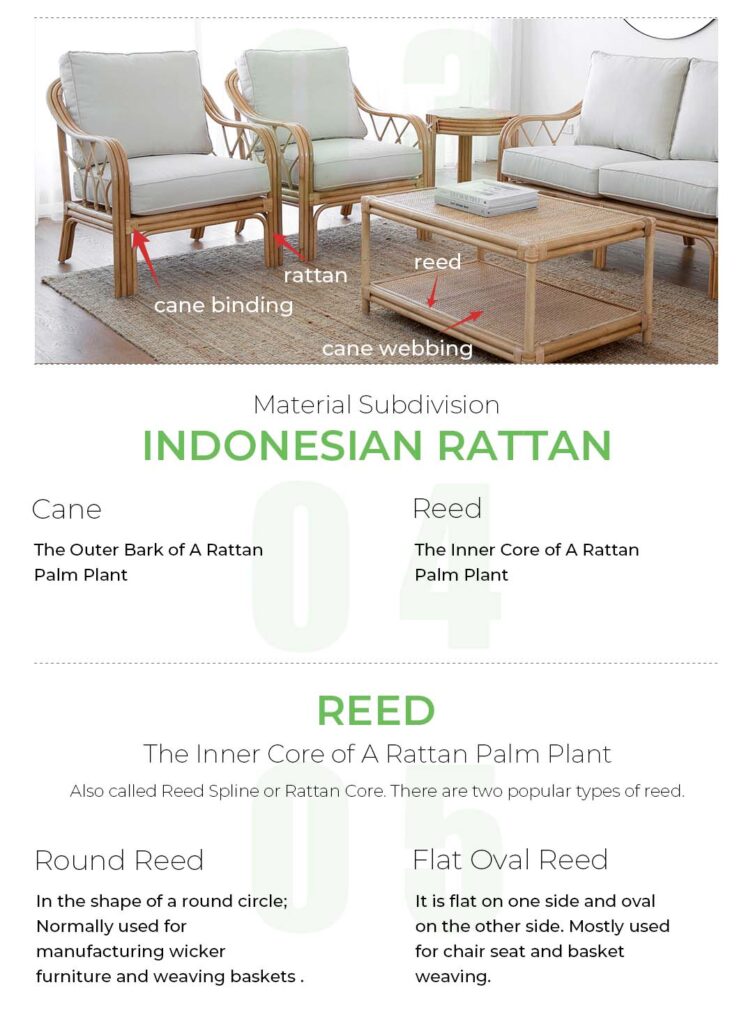

In Leisure Touch Rattan, we offer a wide range of products to cover your diverse project needs. No matter whether you are looking for rattan, cane, or reed materials, we can satisfy you with sustainable and durable plastic alternatives.
Product Specifications
Now, back to the theme of this article, which is rattan cane webbing roll. If you are thinking about purchasing a premier cane webbing roll from Leisure Touch Rattan, you can start to measure the sizes where you are going to cover with the materials. As a sophisticated rattan cane webbing supplier with decades of experience, we offer both natural and synthetic options for you to choose.
For LTR’s natural cane webbing rolls, only the width of products can be customised, and the customisation range is 35cm-100cm, with at least 5cm as the interval; such as 35cm, 40 cm, 45cm and so on. No matter whether you prefer hexagonal, square or close woven cane webbing sheets, the product length can only be 15m.
For the high-quality PE plastic cane webbing rolls, the length of the hexagonal and square cane webbing rolls can only be 30m while the length of close-woven cane webbing is 15m only. For this synthetic option, the width range is different from the natural ones which is 40-100cm. Plastic cane webbing roll is also called “plastic rattan webbing pre_weaved patches”, “cane webbing roll”, “cane mesh roll”, “rattan cane webbing roll” and so on. If you would like to have more personalised sizes, you can contact LTR’s sales specialists for more details. We can start to prepare and complete your bulk order for cane webbing rolls in a short period!
Popular Styles of Cane Webbing Rolls
After finishing measuring and deciding the sizes you need for your cane webbing roll materials, it is time for you to choose the styles that you like for your construction or decoration projects. At Leisure Touch Rattan, there are three classic types of cane webbing that are popular to be chosen, which are hexagonal, square and close-woven cane webbing panels.

Radio Weave Cane Webbing is designed with the pattern of a square. It is often called square pattern cane webbing rolls in the furniture decoration market. This type of cane webbing panel is woven with thin and flexible cane strips overlapped horizontally and vertically, which is particularly eye-catching and suitable for your natural-style home decorations.
Hexagonal Cane Webbing, also called octagonal cane webbing, star pattern or open weave cane webbing by people. Although it is commonly called hexagon rattan cane webbing by people, it is crafted with the pattern of the octagon instead of the hexagon. Compared to the radio weave cane webbing, this style is more expensive as it has an additional handcrafted manufacturing process. In order to create the visual effect of a star or octagon, handicraftsmen need to manually insert long rattan cane trips by the edges of the classic square patterns at a 45-degree angle, which demands time and exquisite crafting skills. This style is common to be seen on the cabinet doors or wall decorations.

Unlike the two patterns mentioned above, the Close Woven Cane Webbing is not designed with hollow patterns. Instead, for this style, the cane strips are closely woven together, showcasing a unique charm of modernity and maturity. For each classic style that we mentioned here, Leisure Touch Rattan not only offers both natural and excellent PE plastic selections but also provides you with a comprehensive customisation service, helping you tailor the desired cane webbing rolls for your home decor, furniture making or DIY projects.
Manufacturing Process of Rattan Cane Webbing Rolls
Now, moving to the manufacturing process of rattan cane webbing rolls, I am going to introduce LTR’s 11 production steps of natural cane webbing rolls for you. As a mature cane webbing supplier, we always strictly control every manufacturing step to deliver you cane webbing rolls with the highest quality, helping you complete your projects with eye-catching materials.
- Raw Material Sorting: The first step of crafting high-quality cane webbing is to strictly select and sort premier raw materials to ensure product quality.
- Raw Material Separation: The second step is to separate the rattan cane we need from the rattan core.
- Rattan Thinning Process: To craft exquisite cane webbing rolls, we need to thin the natural cane material to achieve the desired thickness and flexibility.
- Material Classification: Then we need to classify the cane materials by different lengths and widths so that the manufacturing processes will be more convenient.
- Material Jointing: In this step, adhesive techniques are used to extend the length of cane strips for later use.
- Weaving Preparation Step: We will rotate the prepared cane materials into disc shapes so that they are ready for the machine-weaving process.
- Machine Weaving: The disc-shape cane materials are put on the automated weaving machines. During this step, the cane strips will be woven into large panels by machines.
- Handcrafted Detailing: After the machine-weaving process, skilled craftsmen will manually do some detailing to the cane webbing rolls to achieve a better look. For example, the hexagon cane webbing rolls need people to insert long cane strips to create different visual effects, which cannot be done by machines.
- Detail Refinement: we need to manually repair any flaws from the machine weaving process to ensure perfection in every detail.
- Rolling: The woven cane webbing should be winded into roll forms for convenient packing and delivery.
- Packing: The last step is to pack the materials so that they can arrive at the destination in good condition.

Singeing: If you would like to achieve a better look at your cane webbing materials, Leisure Touch Rattan’s singing skill can help you a lot! Singeing is a type of specialized technique that is used on natural cane webbing roll materials to refine their surface and enhance their aesthetic. This method specifically targets the burrs or rough edges naturally present on cane webbing rolls. By utilizing a blowtorch, the burrs are effectively burned away, leaving the cane webbing smooth and polished for further use.
This process not only showcases the craftsmanship involved in crafting beautiful cane webbing rolls but also highlights the heat-resistant property of LTR’s natural cane materials. This innovative method ensures a refined finish, making your natural cane webbing roll an excellent choice for both functional and decorative applications.
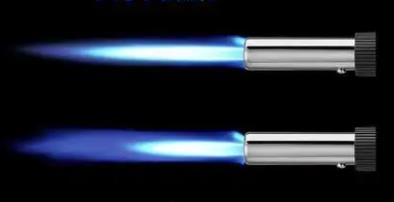
Bleaching: Bleaching is craftsmanship only applied to natural cane webbing, offering two main options: 100% bleached and semi-bleached. Semi-bleached cane webbing retains a slightly yellowish tone. If you are considering decorating furniture or interiors with natural cane, this process is worth exploring. Bleaching can help enhance the uniformity of the cane colour and can make the material easy to dye in various colours. On the other hand, plastic cane webbing does not require bleaching, as it can be produced in a wide range of colours during the manufacturing process.
In addition to bleaching, natural cane webbing comes in two primary colours: yellowish and greenish tones. The yellowish tone is normally more expensive due to its eye-catching appearance and the additional required step to remove the greenish cane material. Its refined aesthetics make it a premium choice for high-end decorative applications, bringing a sense of natural beauty to your furniture or spaces.
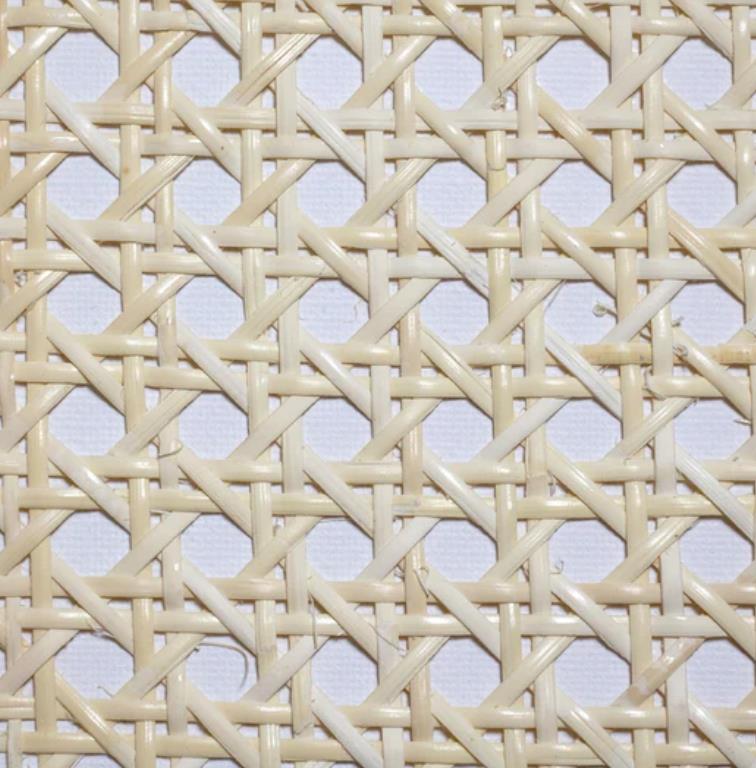
If you need help in selecting the right style for your projects, consult our sales specialists right away for more details!
New Designs
Plastic Cane Webbing for Outdoor Settings
As one of the leading suppliers of cane webbing rolls in the industry, we offer a wide range of options to suit your needs. In addition to a variety of styles, you can choose between natural and synthetic cane materials. For those who prioritize durability and long-lasting performance, our artificial cane webbing rolls made from recycled PE plastic are the ideal choice. While our existing synthetic cane webbing is more durable than the natural cane, it is not recommended for outdoor use, as it cannot withstand the harsh elements as effectively.
Therefore, Leisure Touch Rattan’s R&D team dedicates a lot of time and effort to developing a new type of synthetic PE cane webbing roll, designed specifically for outdoor use to enhance your surroundings. Like our previous plastic collection, this new design also offers a wide range of styles and patterns to suit various applications.
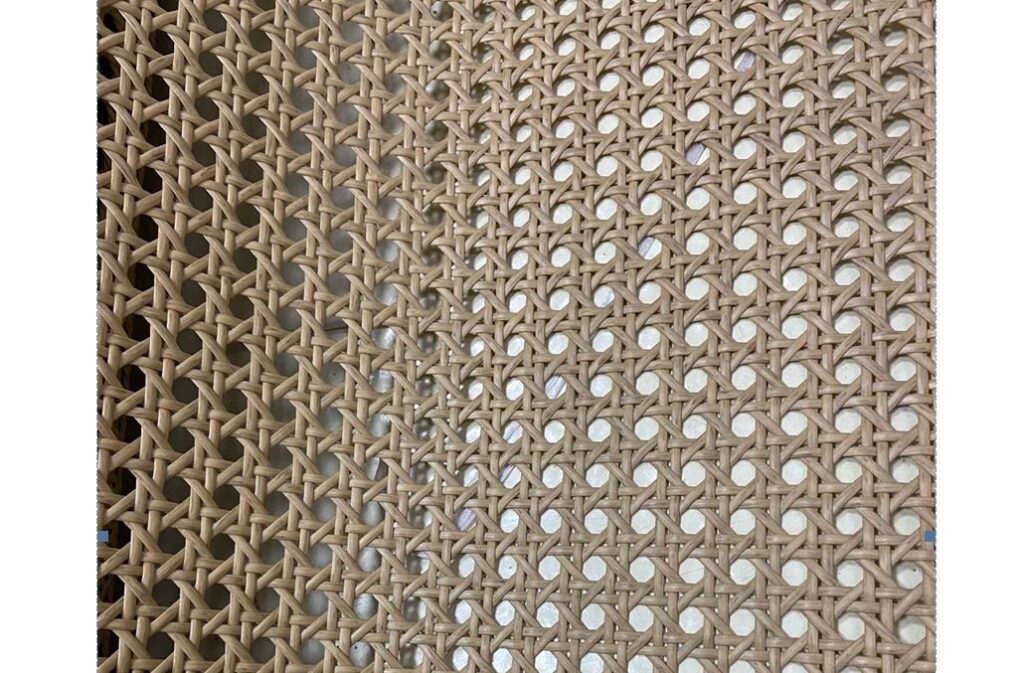
Although this new plastic rattan webbing pre_weaved patch is also crafted from sustainable PE plastic, it is significantly stronger than the old plastic cane webbing collection. Offering weather resistance, anti-corrosion properties, insect protection, and colourfastness, this new material is ideal for outdoor use to enhance the aesthetics of your furniture or outdoor spaces. With our new PE cane webbing, you can create a stunning outdoor retreat that requires minimal maintenance, combining beauty and functionality effortlessly.
Plastic Rattan Roll
In order to provide more options for customers to decorate their walls, ceilings or furniture pieces, Leisure Touch Rattan also offers versatile and stylish plastic rattan rolls to satisfy their diverse needs and preferences.
Unlike our cane webbing roll collection, our rattan rolls only come with the synthetic option, which is made entirely from durable and eco-friendly PE rattan. Designed to mimic the look of natural rattan, these rattan rolls are woven into large, flexible sheets by automated machines, making them ideal for a wide range of decorative applications such as lampshades, home decor, wall coverings, and ceiling accents.
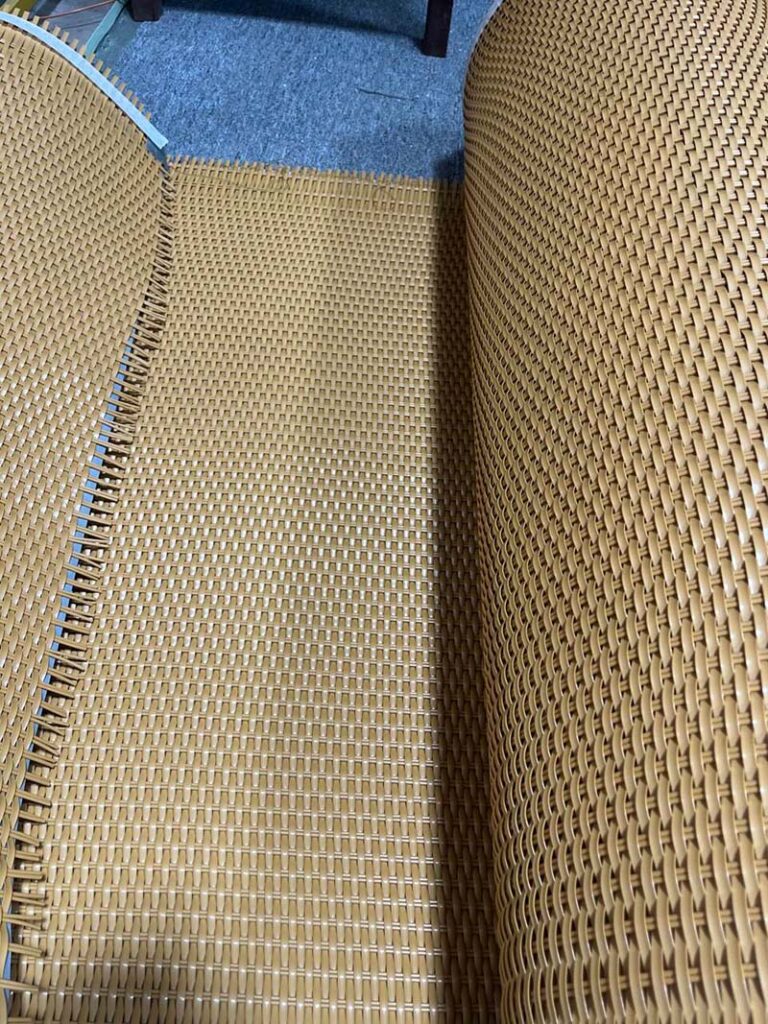
Currently, we offer plastic rattan rolls as custom products, meaning we can produce rattan rolls in any size, colour, and pattern to suit your specific needs. However, to simplify the purchasing process for our customers, our R&D team is actively working on standardizing our rattan roll options.
Our pre-designed rattan rolls will feature fixed patterns, colours, and sizes, allowing for easier selection and purchase for our valued customers. Stay tuned for the launch of Leisure Touch Rattan’s standard rattan rolls, which will add a touch of mystique and beauty to both your indoor and outdoor spaces in the near future!
Frequently Asked Questions about Cane Webbing Rolls
After learning about LTR’s natural and plastic rattan webbing pre_weaved patches, I believe that you have already gained a better understanding towards this product. With comprehensive knowledge about cane webbing rolls, your material sourcing process will be easier and more convenient! Now, let’s dive into more related information about this novel, stylish and practical material!
What is the history of cane webbing rolls?
Cane webbing has a rich history that dates back to ancient Egypt, where it was used in crafting furniture, including King Tutankhamun’s woven daybed. For over three millennia, the use of cane webbing has remained largely unchanged, with the same rattan palm materials still used in furniture caning today.
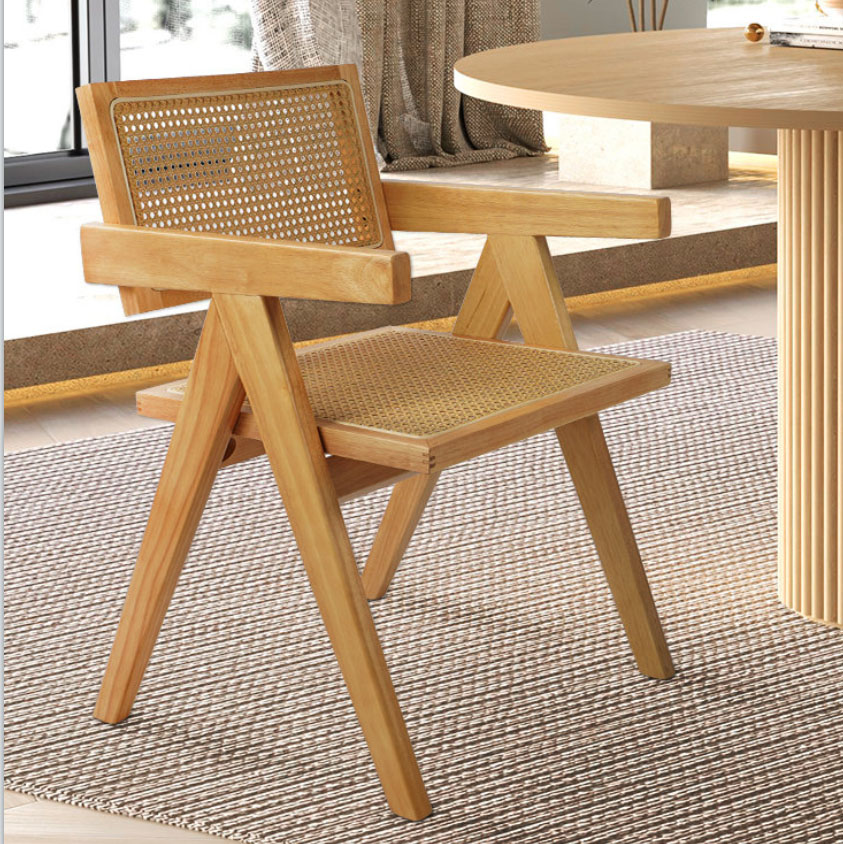
During the Regency period in England, cane webbing gained prominence, particularly in furniture designed with Far Eastern influences, seen in places like the Brighton Pavilion. Because of this, the trend of cane webbing has increased a lot. It is then became a popular choice for chair seats and backrests. By the late 1600s, English craftsmen introduced cane weaving for chairs, refining the technique over time to create the tight, hexagonal patterns we recognize today. In modern society, cane webbing remains popular for its durability, flexibility, and aesthetic charm, used in both traditional and contemporary furniture designs.
What are the benefits of cane webbing rolls?
As a durable and environmentally friendly material, rattan cane webbing rolls not only have an aesthetic appeal but also have diverse benefits to help elevate your space ambience. Crafted from sustainable natural rattan or recycled PE plastic, both natural and plastic rattan cane sheets are good for the environment, and bring no harm to our living surroundings. Besides, rattan cane material is easy to clean; using this material to decorate your furniture or interiors can largely save your maintenance effort.
LTR’s newest cane webbing roll design is much stronger and is suitable for outdoor use, It is weather-proof, waterproof, anti-insect, anti-corrosion and non-fading. Manufactured into a large woven sheet, rattan cane webbing roll is easy to install. If you need a detailed guide about installation methods, refer to this article for further information!

How long is the product warranty?
At LTR, we stand behind the quality of our cane webbing products and offer a reliable product warranty to ensure customer satisfaction. Whether made from natural or synthetic cane, the lifespan of our webbing typically ranges from 1 to 3 years, depending on usage and environmental factors.
For example, when cane webbing sheets are used in backrest designs, they tend to last longer than the cane webbing seat cushions, as seat cushions are subject to more frequent pressure. Our synthetic plastic cane webbing performs exceptionally well in high humidity environments, as it resists water absorption and won’t rot, unlike natural cane, which will absorb moisture and develop mould in the same humid setting.
Additionally, plastic cane webbing is normally more heat-sensitive and may shrink when exposed to high temperatures, while natural cane retains its form without shrinking under heat. LTR’s cane webbing is designed to be durable and practical, offering both stylish design and long-lasting performance in various settings, backed by our commitment to quality and warranty support. If you have any quality issues, contact us now for further assistance!
How do you normally pack your cane webbing rolls?
At LTR, we ensure that our cane webbing rolls are securely packed for safe delivery. After processing, the webbing is carefully rolled into individual bundles, making it easier for packing and transportation. Our standard packaging involves two layers of protection. First, the webbing is sealed in a transparent plastic bag to protect it from dust and moisture. Then, we wrap it with a durable green woven bag for an additional layer of security. This double-layer packaging minimizes the risk of damage during transportation. If you prefer an alternative packaging method, such as a paper carton, we are happy to accommodate special requests to meet their needs.
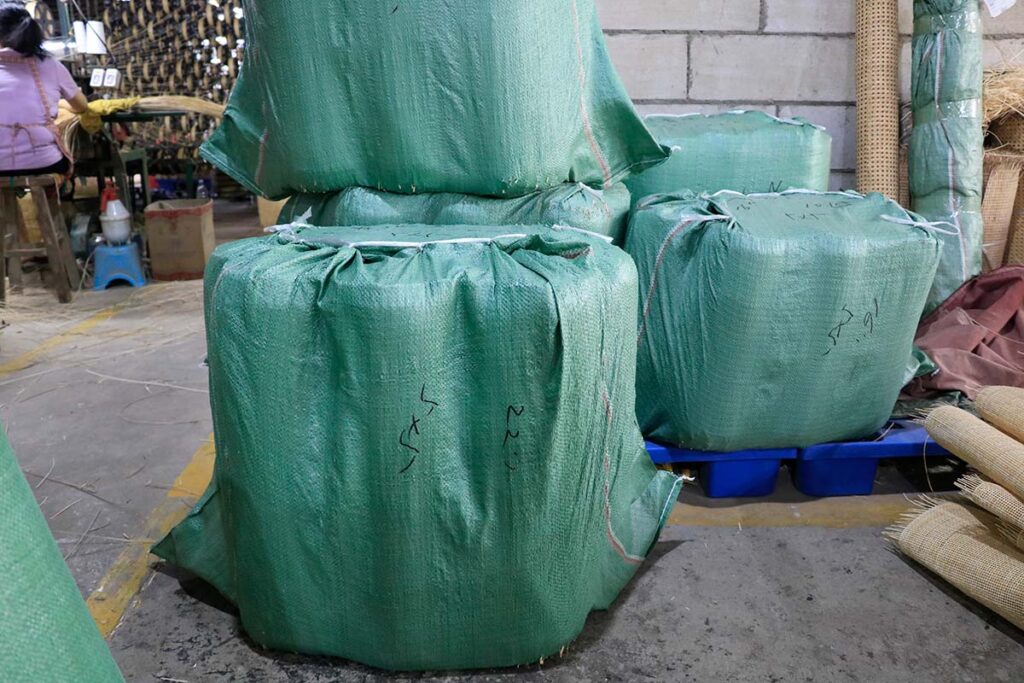
What are some common applications of rattan cane webbing rolls?
Cane webbing rolls are highly versatile and can be used in a variety of decorative applications, adding a natural, textured appeal to both indoor and outdoor spaces. One popular use is in wall and ceiling decoration, where the intricate patterns create a stylish, organic look that complements a range of interior styles.
Cane webbing is also commonly used in furniture decoration, such as chair seat backs and armrests, offering both comfort and visual interest. It is especially prized for its ability to enhance the aesthetic of traditional and modern furniture alike. In modern interior design, cane webbing is also widely used in cabinet doors for decorative purposes.
In lighting design, cane webbing is normally used to create beautiful lampshades, allowing light to filter through in an elegant and soft way. Additionally, it can be used for fence and screen decorations, adding a rustic or tropical flair to your outdoor spaces. With its flexibility and durability, cane webbing is ideal for lots of creative applications, adding texture and charm to any project.

How to install or attach cane webbing rolls?
1. Prepare all necessary materials for your cane webbing installation. What you need is a staple gun, wood glue, scissors, a utility knife, a measuring tape, a damp cloth and a straight ruler. If you are attaching natural cane webbing, cool water should be ready.
2. Measure the area where you will install the cane webbing roll. Then, cut the material based on the size you need. Leave an extra inch or two on each side for later adjustments, ensuring complete coverage of the area.
3. Clean the frame (your target area) thoroughly to remove dust, dirt, or old glue.
4. Rinse the material gently with water so that the natural cane webbing can absorb water and stretch, which will be flatter and easier to install. However, this step is not necessary for plastic cane webbing roll since it will not absorb water.

5. Position the cut cane webbing over the frame, centring it so that it is evenly distributed on all sides.
6. Use a staple gun to secure the material. Start at one side of the frame, applying staples every few inches along the edge. You can also use wood glue instead and apply it to the frame before placing the cane down.
7. After securing the cane webbing, use scissors or a utility knife to cut any excess cane webbing material, ensuring a neat finish around the edges.
8. Clean the installed cane webbing with a damp cloth to remove any debris. If you use glue, allow it to dry completely before cleaning.
How to repair the cane webbing rolls if it is broken, rotten or bitten by bugs?
This issue is common with natural cane webbing rolls, but repairing them is an easy task that you can handle by yourself. If you notice a damaged section, start by carefully cutting and removing the affected part. Next, replace it by weaving a new, undamaged cane strip into the area. For the best results, ensure the new strip starts and ends at least three weaving intervals beyond the damaged section for a seamless finish. If the damage covers a larger area, it is best to contact us for professional assistance or replacement options. With proper repair techniques, your cane webbing can regain its original charm and functionality.
Where to buy stylish and high-quality cane webbing roll materials?
Since cane webbing is increasingly popular in homes, commercial spaces, and furniture design, it is essential for you to choose a reliable supplier. High-quality cane webbing should balance durability with aesthetic appeal. As a leading company in the furniture materials industry, Leisure Touch Rattan offers a wide variety of styles and three distinct material options to meet your diverse needs.

For indoor use, we provide natural and plastic cane webbing, allowing you to select the perfect fit for your space. For outdoor applications, our innovative PE cane webbing is an excellent choice. It combines the natural look and unique design of traditional cane with enhanced durability to withstand harsh weather conditions.
Whether for creating a cosy indoor vibe or a relaxing outdoor retreat, LTR’s cane webbing products deliver exceptional quality and style, ensuring your space feels comfortable, natural, and inviting.
Start Your New Journey to Home Decor
We hope this article has provided valuable insights to guide you in purchasing cane webbing materials. If you are a client of Leisure Touch Rattan, your purchasing process will be even simpler. This guide not only detailed the various styles, production processes, and exquisite craftsmanship behind LTR’s cane webbing but also highlighted key considerations such as product sizes, colour selections and packing methods during the purchasing process.

By covering these essential aspects, I believe that you now have a thorough understanding of the cane webbing roll materials. If you need further assistance or personalized recommendations, do not hesitate to reach out to us. Our professional sales representatives are here to help you make the best choice for your projects!

